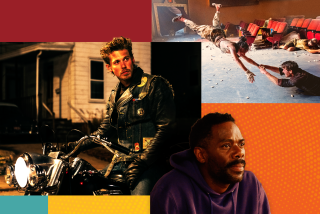Cowboy noir: The darker side of the genre
The western has always been the story of a man and his gun, but as the genre teaches us time and again, just as a man can always find a new reason to fire a Colt revolver, so can a filmmaker.
Built on myth and chaparral, the western was for decades an important part of the Hollywood studio mix, at times accounting for upward of a quarter of total production. Nowhere was it more important than at Columbia Pictures. From 1930 through the mid-1950s, the house built by the pugnacious Harry Cohn produced more westerns than any other major studio, many featuring second-tier talent and stars on the fade. Many of the films were forgettable, but others were remarkable. Starting today, the UCLA Film and Television Archive begins screening 10 produced at the studio after World War II, the era in which the genre achieved its apotheosis.
All the titles in the program, which carries the literally accurate if somewhat misleading title “Columbia Restorations: Westerns in the Age of Noir,” have been fully restored, with new prints struck from the negatives; half these refurbished prints have never been screened before and most of the rest have been shown only once in Europe. If that’s not enough incentive to grab a seat at UCLA’s James Bridges Theater, consider that Sony -- which owns the Columbia library -- has released only one featured title on DVD and has no plans to release the others. You may be able to rent a DVD copy of Delmer Daves’ tense psychological showdown “3:10 to Yuma” (1957), in which a smoothly seductive Glenn Ford matches wits against a jittery Van Heflin, but here’s the chance to see these films the way they were meant to be seen.
Sony’s refusal to step up to the DVD plate is too bad, not only because these are -- for the most part -- exceptional entertainments, but also because the western has always been central to how we understand ourselves as Americans. The genre didn’t just keep the Western frontier open, at least symbolically; it became our Ur-movie narrative, the template for our self-mythology. In the industry’s early years, that narrative commonly observed a fairly simple cowboys-and-Indians arc. After World War II, notes historian Edward Buscombe, the major studios produced westerns distinguished by social themes and the related “tendency” toward more complex character development. The war and its aftershocks, along with the climate of fear provoked by the Red scare, left their mark on the genre, but so did juvenile delinquency, pop psychology and the familiar tug between radical individualism and social conformity.
Most of the films in this Columbia sampler don’t carry their social issues heavily enough to bog down the story or the characters. In George Sherman’s “Reprisal!” (1956), Guy Madison comes up against three racist white brothers (one of whom, rather disconcertingly, is played by Edward Platt, Max’s boss on the sitcom “Get Smart”) who have lynched a pair of Native Americans. As in many of the films in the series, Madison’s character enters a community in the grip of villainy and brushes off the suggestion that he get involved. He echoes the isolationist cry of the Loner, insisting that the fight isn’t his -- “What’s it got to do with me?” or “This has nothing to do with me” or “I never asked nothing of nobody” -- as his love interest wrings her hands prettily and wonders, “Why doesn’t somebody do something?”
Madison’s character does do something -- something good and violent -- but as in Phil Karlson’s more richly conceived “Gunman’s Walk” (1958), “Reprisal!” sounds the call to racial equality principally with an appeal to old-fashioned humanism rather than an invocation of radical social change. In both films, racial tolerance has less to do with civil rights for Native Americans -- or the African Americans who are the aggrieved Indians’ obvious metaphoric doubles -- but as an index of white righteousness. The Native American characters in these films may no longer be the shrieking anonymous savages of Hollywood’s tarnished past, but most are still played by white actors and tend to be alternately out of the picture or as inert as a cigar store’s wooden Indian.
Since the western is essentially about men, it’s no surprise that most of the women tend to be as dull as the Native Americans and generally less frisky than the horses. A notable exception is Barbara Stanwyck’s unhinged matriarch in Rudolph Mate’s psychodrama “The Violent Men” (1955). Eyeballs popping and crinolines rustling, Stanwyck plays the wife to land-grabber Edward G. Robinson like some cattle-queen Lady Macbeth, scheming and betraying everyone in sight. Her character’s unbridled lust -- for power, for men -- confirms the film’s noir bona fides, and it’s a pleasure to see at least one femme fatale skulking about in petticoats. A fine Ford plays the Civil War veteran who wants nothing to do with nobody while Brian Keith (the uncle from the TV series “Family Affair”) makes a persuasive scoundrel, even with his hair dyed boot black.
Despite the program’s title, most of the features are neither as darkly shaded nor as despairing as a true noir western like Raoul Walsh’s late 1940s classic, “Pursued.” That doesn’t mean the films here aren’t steeped in murder and mayhem with an occasional jolt of sadism -- there’s a squirming bit with a hook in Budd Boetticher’s 1957 “Decision at Sundown” -- only that their moral landscape is often more clearly defined than in most pure noirs. Out on these ranges, problems are fundamentally solvable, more a question of social control than of existential dread. The good guys usually draw their guns faster than the bad ones, and although passions always run high -- and sometimes scorching hot -- rarely do they also run off the rails.
Noir or not, “The Violent Men” isn’t just a terrifically enjoyable movie -- it’s a real movie, a movie-movie. Like the rest of the features in the series, it’s been burnished with old-fashioned craft. Professionally made, sometimes spectacularly acted, these are movies that make sense and are actually about something. Sometimes they’re about racism, capitalism run amok and how violence can eat away at a man’s soul (as it does to Ford in Henry Levin’s 1948 “The Man From Colorado”); sometimes they’re just about a grace note or two. Boetticher’s “Decision at Sundown” is one of the late director’s and star Randolph Scott’s lesser Columbia collaborations, but it’s nonetheless filled with moments that make you gasp. Like the close-up of Scott securing his holster to his thigh to signal his character’s lethal intentions or the way another man tosses aside his hat before walking into a bullet.
Boetticher’s brilliant “The Tall T” is filled with such moments. Released in 1957, this was the second of seven features that the late director and Scott made together and every bit as key to western movie history as the better-known collaborations of John Ford and John Wayne. Soon after the film opens, a wealthy middle-aged woman, Doretta (Maureen O’Sullivan), her cad husband and Scott’s character, a former cowhand called Brennan, are kidnapped by a gang led by Richard Boone’s smiling sociopath. One bad thing leads to another and Doretta and Brennan are eventually locked in each other’s arms in a cave doing what comes natural. By the time Scott growls, “You’re more woman than most,” in a sandpaper rasp that Clint Eastwood clearly made a close study of, you’ll know this is undeniably more movie than most.
*
Manohla Dargis is a Times film critic.
*
Columbia Restorations: Westerns in the Age of Noir
Where: James Bridges Theater in Melnitz Hall, UCLA, Westwood
When: “The Violent Men” and “Gunman’s Walk,” tonight; “3:10 to Yuma” and “Face of a Fugitive,” July 17; “Reprisal!” and “Decision at Sundown,” July 19; “The Man From Colorado” and “A Lawless Street,” July 25; “The Tall T” and “The Stranger Wore a Gun,” July 27. Screenings begin at 7:30 p.m., except on July 27, when it begins at 7 p.m.
Price: $7 general; $5 students, seniors and UCLA Alumni Assn. members with ID. Tickets can be purchased at the box office one hour before show time
Contact: (310) 206-FILM or www.cinema.ucla.edu
More to Read
Only good movies
Get the Indie Focus newsletter, Mark Olsen's weekly guide to the world of cinema.
You may occasionally receive promotional content from the Los Angeles Times.










